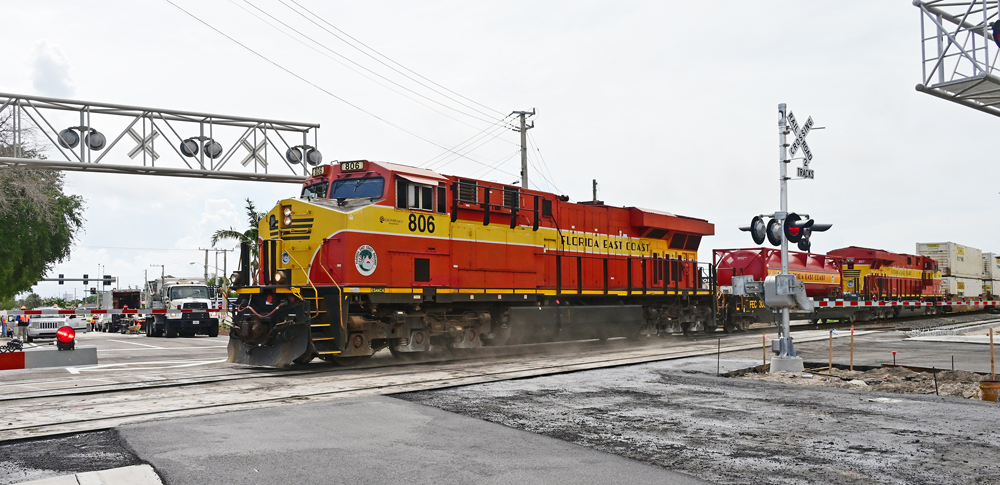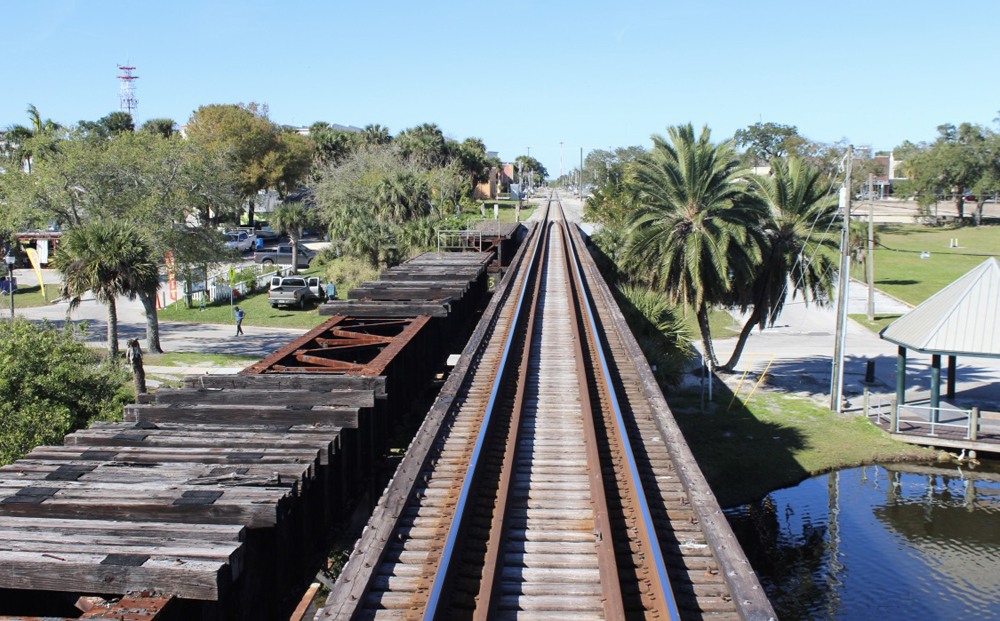
WEST PALM BEACH, Fla. — It’s only 13 miles of a 129-mile project, but this week’s planned activation of a second main track between West Palm Beach and Jupiter, Fla., represents tangible progress in Brightline’s northward expansion.
Restoration of the second main on Florida East Coast’s line to Cocoa, Fla., helps establish a fluid, 110-mph-capable corridor where fast passenger trains and steady freight traffic can peacefully coexist. The activity also illustrates the complexity of adding capacity to enable Brightline trains to reach Orlando International Airport by the end of 2022, according to the company’s latest estimates.
Passenger service south of West Palm Beach has been suspended since March 2020, but is scheduled to resume later this year on a date to be determined [see “Brightline to resume South Florida service in November,” Trains News Wire, Aug. 10, 2021].
Through 6 p.m. on Friday, Sept. 17, crews are integrating the new track’s switches and signals with the existing single-track main. The process involves providing flag protection for motorists at each of 17 highway grade crossings in five communities while systems are deactivated and cut over, then testing all components before moving on to the next crossing. Stoplights at nearby intersections need to be coordinated with train movements, so those interfaces must be linked as well. A total of 155 highway crossings will have to be similarly modified.
Construction on the West Palm Beach-Cocoa project began in mid-2019, along with an entirely new 35-mile east-west extension following Florida Highway 528 to the airport [see “Orlando Bound,” September 2020 Trains].

The previous double-tracked FEC north-south main had hosted fleets of streamliners to and from the Northeast and Midwest until service ended following a 1963 strike; a state-mandated Jacksonville-North Miami train made its last run in 1968.
The second main was soon eliminated over most of the route and the remaining track —along with buried cables and utilities — rearranged on the right-of-way. Now that work south of Cocoa is being reversed with more space added between track centers and dwider-radius curves to accommodate higher speeds.
Although repositioning crossing protection and then re-establishing double track is a monumental task, replacing or restoring more than two dozen aging fixed-span bridges and reconstructing the drawbridge at Jupiter are most significant.
Tracks are being raised over the Loxahatchee River so that a new bascule span will allow larger pleasure craft to pass underneath without requiring a bridge lift. The old bridge was closed for two days in August, and more work is expected during the coming months. A Brightline video below shows the scope of the project.
The much longer drawbridge and approach trestle over the St. Lucie River at Stuart, Fla., will remain a single-track structure until after service to Orlando begins, but work continues on replacing four fixed spans with new double track bridges over Crane Creek at Melbourne, Fla., and three other locations.














Before any increase in speeds, Brightline needs to stop letting the FRA and others pretend they’re not doing enough to stop drivers and people getting hit while doing stupid crap at crossings, and stop being a scapegoat for the actions of others, driving around crossings is illegal, walking along tracks is private property and again illegal, If people are doing illegal things why is Brightline’s name is involved? Just what in the hell the railroad is supposed to do when drivers are driving around crossing gates, and walking along railroad property?
Mr. Rice, on whose ROWs are passenger trains supposed to operate at the speeds you specify? And how many times will an auto trip, even on an interstate through heavily populated regions, will speeds be reduced significantly below 75mph account congestion? Or are you in favor of state DOTs grabbing more homes and businesses, primarily in black and brown neighborhoods where the people have no political standing to fight back as history shows, to widen those interstates to 15 lanes in each direction. Maybe all the passengers need to do is reliably operate in the 90mph range with added/restored mainline track capacity that allows the freights and the passengers to co-exist under normal operating conditions. That and attractive on board amenities may be all that’s needed.
I am an advocate for Amtrak getting out of the rail business and be a regulator and traffic manager like the FAA is with airlines. Amtrak should be selling concessions for time slots on rail they own or have rights too. If the traffic supports dedicated ROW, then Amtrak would arrange the funding for such routes.
As for the market segmentation by speed, obviously not all segments support the 100-250mph premise. It would have to be developed over time as part of the Amtrak strat plan. No different than the FAA setting up lanes for high volume flights for Atlanta-Hartsfield, Chicago-O’Hare or the Port Authority of NY-NJ.
For passenger rail to survive it needs to permanently move up into the 100-250mph service segment. Cars obviously fulfill the 45-75mph service area and planes cover the 250-450mph segment.
Brightline has 3 things going for it, Tampa, Orlando and Miami. All destinations for tourism, domestic and foreign.
The aforementioned Lincoln Service with Amtrak (which I have ridden several times) is more focused around as an alternate form of transportation acting as a car substitute. Until Illinois can get their act together with UP on the unending upgrades and raise the speeds, this will never be more than what it is today, Chicago-St Louis while sleeping.
I love everything about this project. If only more railroads were as ambitious as Brightline/FEC! For example, the Lincoln service between Chicago and Saint Louis is approximately the same distance, will be operated by the same equipment, and have a similar top speed – and the populations of the two cities is even higher than Miami and Orlando. Can you imagine if UP decided to bring back passenger service in a few corridors, following the Brightline example? So long as Brightline proves to be profitable, I think the market is nearly ready for such a rail renascence
Great progress Brightline. This is building a case for private passenger service in population dense corridors again.